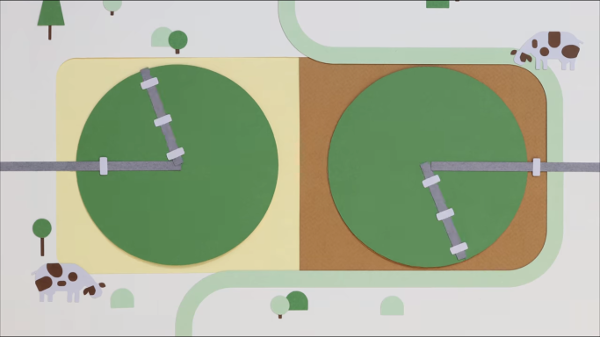Globally, ~67% of the water withdrawn from rivers, lakes and groundwater is used for agriculture, making the food sector the largest user in the Nexus worldwide9. In Alberta, this number is a bit smaller, where agriculture is allowed to withdraw up to approximately 45% of all water allocated in the province2. Food is a highly consumptive use of water. Unlike cooling or showering, only some of the water used in agriculture is returned to the river. Globally, agriculture consumes ~93% of withdrawn water9. In Alberta, agriculture has consumed ~65% of withdrawn water2. As the population increases and more people need to eat, more water will be withdrawn and consumed to meet this increased demand. This presentation offers further breakdown of water resource consumption.
This growing demand for food is already placing additional pressure on the shared water supplies of the Nexus. In response, irrigators and farmers are using a variety of techniques to reduce their water consumption, which is helping reduce stress on our shared water resources and the environment6.
While much of the water used in the food sector is consumed by plants and animals, a portion is also returned to the environment through runoff, evaporation, seepage from canals, and as bypass water. Bypass water is water that is left in the canal that is between the pumping station and the farm. This water bypasses the farm because it is no longer needed after pump-shut off and is returned to a water body.

In the Bow River Basin, water is used in the food sector to:
Irrigation for crops consumes essentially all agricultural water. In Alberta, this water is managed by irrigation districts and private irrigators. Most irrigation takes place in the southern part of the province, where the practice helps increase crop yield in the hot and dry growing season. Alberta’s irrigation network of reservoirs, canals, pipes, ditches, pumps and diversions also provides water to communities, creates recreational opportunities, and supports habitat for fish and wildlife, including wetlands3.
Livestock require water for drinking, and the primary driver of how much water is consumed by livestock is the number of livestock on the farm. Cattle require 43 litres per day of water for drinking, on average, but this number can vary depending on the time of year, gender, diet, level of activity, pregnancy, breed, and growth stage1.
Water withdrawn for food processing has a variety of uses, including heating, cooling, washing, and cleanup.
Water is used in slaughterhouses to clean the carcass and the livestock pre-evisceration, and to wash and sterilize the facility. Water use in dairy processing plants varies depending on the product (e.g. cream cheese, butter, cottage cheese) but is generally used for cleaning and to cool heat exchangers that are used in microbiological treatment.
Conserving water in the food sector has tremendous potential to free-up water for other parts of the Nexus including the environment, energy, and people. Much has already been done and continues to be advanced in terms of water efficient irrigation in Alberta. For detailed information about recent gains in water efficiency in agricultural production in Alberta see the “Looking Back” report 2017 by the Alberta Water Council.
A 5% efficiency gain in the irrigation sector would be equal to the estimated annual consumptive water use by all municipalities in the South Saskatchewan River Basin5.
Water management techniques and technological advances in the food sector are aimed at maintaining food yield while reducing the amount of water required. Irrigators and farmers are closely monitoring their water use and implementing the best available technologies5. Some examples of these practices already in place include:
Table 1: Approximate water requirement for a group of representative crops in Alberta8
| Crop type | Approximate growing season crop water requirement (mm) |
|---|---|
| Alfalfa | 600 |
| Barley | 400 |
| Canola | 450 |
| Dry bean | 350 |
| Dry pea | 350 |
The Alberta Water Nexus simulator is an engaging tool that asks users to make decisions regarding water use in the Bow River Basin in the year 2030. Users are then able to view the impact of those decisions on our water resources. The simulator uses real-life examples from the major consumers of water in the Basin including the food and energy sectors, and people.
In the food section of the simulator, the user is prompted to make decisions about growing crops and raising livestock in the Bow River Basin to meet the needs of an increased population. The user decides which crops to plant and in what proportion, and how many livestock to raise. Different irrigation technologies can also be explored to view how irrigation efficiency plays an important role in helping to reduce water use in the food sector.
Everyone and every sector in the Alberta Water Nexus shares a common water supply. This supply is limited, and quality and quantity vary on a year by year basis, making it especially important to plan in advance for how to share the water in a drought. All the sectors in the Nexus are connected, therefore balancing water between them can be complicated. Actions in the Water Nexus also have cascading impacts into other parts of our society like the economy, our health, and even politics. These cascading impacts can be both positive or negative.
For example, if a farmer decides to plant a crop that does not require irrigation, energy will be conserved by not needing electricity for water pumps.
Learn more about the connections in the Nexus by clicking here.
We provide Canadian educational resources on water practices to promote conservation and sustainability. Our team crafts current and relevant content, while encouraging feedback and engagement.
The Canada WaterPortal is a registered charity, #807121876RR0001
We recognize and respect the sovereignty of the Indigenous Peoples and communities on whose land our work takes place.
© 2025 All Rights Reserved.